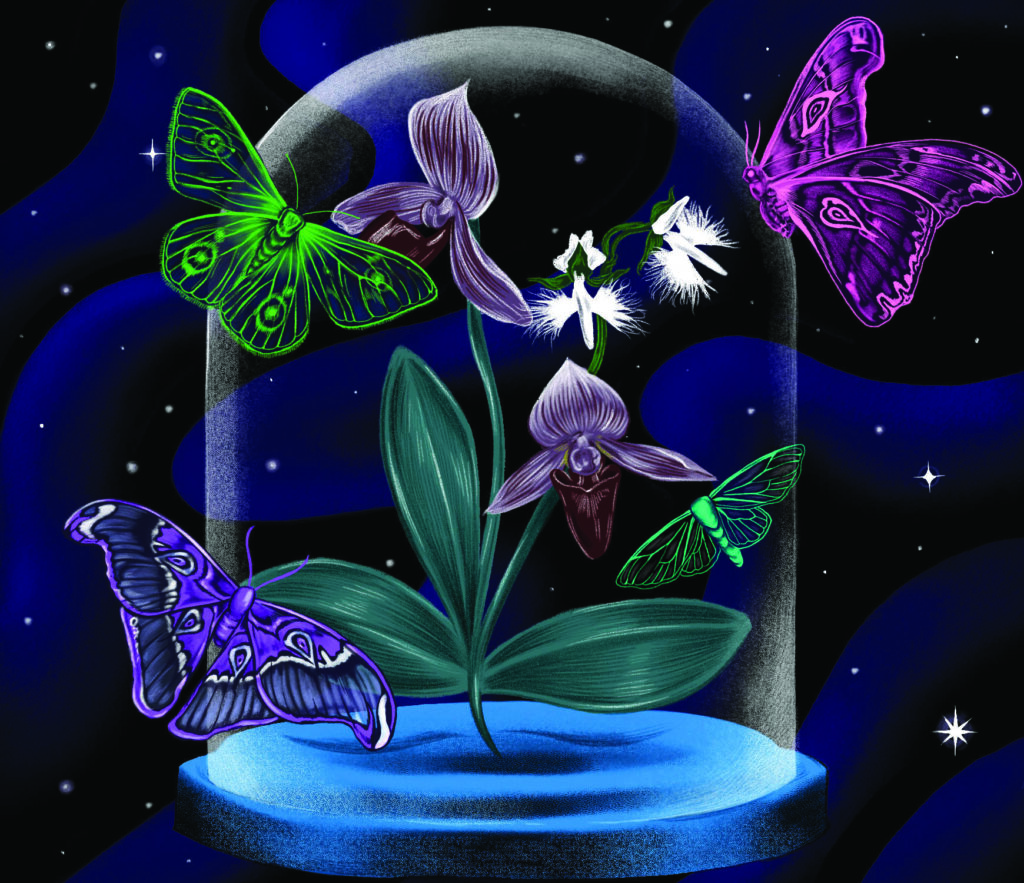
As a lifelong insomniac, I have for years envisioned a Museum of Night, a kind of metaphorical extension of what happens in my mind while the rest of the population is asleep.
The walls of the museum would be gray with glowing flecks of white, the light dimmed to a twilight tenor. There would be nothing unusual about the space, yet it’d seem elastic, as if uncertain how to accommodate its inventory. Which includes:
1. A long glass showcase full of movement. It is a terrarium filled with fluttering moths. There are also large black nocturnal flowers, from which the moths emerge—a petal folds in two, breaks away from the center, and flies off. Some of the moths have golden eyes on their wings, others are a dusty gray. They flap about in different directions, their wings folding and unfolding darkness. Occasionally a light-bellied moth settles on the glass pane, the X-ray of a dream, a still from a nightmare.
2. A 12-by-20-by-15-foot cardboard construction, four black walls painted with streetlamps. On one of the walls, a sign:
CITY OF DREADFUL NIGHT
A VICTORIAN NIGHT WALK
AS EXPERIENCED
IN NINETEENTH-CENTURY LONDON
Beneath the sign, printed by Hamburg and Humbug Holograms & Dioramas, Ltd., a paragraph describes the adventure:
Every city has its nocturnal wanderers, people who stumble about bleary-eyed, desperate for distraction or repose. Daunting avenues that endlessly unfurl and dark scratchy corners where couples cower. Towers and bridges, knots of tension and neurosis. Solitary travelers, like strayed migratory birds, confronting a vastness without coordinates. Every route is limitless. At night infinity takes over and there is no difference between a castle and a prison.
3. On a shelf, a metal box with windows, meters, and dials:
NOCTURNOGRAPH
DEVICE FOR MEASURING NIGHT
(PATENT PENDING)
The machine records various aspects of night. A fluxometer measures degrees of stillness. This is done through the detection of sound frequencies and movement down to the slightest stirring. Attached to the left side of the Nocturnograph is a barometer. A tiny sea of mercury rises halfway in the slender glass tube, indicating placid minutes in the museum. Another feature measures the depth of night, calculated by registering the textures and patterns of darkness, which vary depending on the size of the space they inhabit. But the most intriguing aspect of the machine is its capacity to measure shadows. It claims to record the exact time at which shadows come into being and predicts how long they will remain in existence:
Some shadows are thicker, others more opaque, some denser, others more fluid. Everything depends on the time of afternoon or evening they were born and on how long they have been in existence. Novices (shadows recently created by rearranged objects, new compositions) need to be reminded when to appear and are nudged into being by their elders, who monitor the sun’s movements as they prepare themselves for the moment they will slip into view.
4. A sheet of parchment under glass. Undated. Anonymous.
Excerpt from Memoirs of an Insomniac
Word spread long ago that my mind runs on a twenty-four-hour schedule and that even more space is available here at night. Once the sun has retreated and the moon has entered the sky, all kinds of boarders come a-knocking in search of company and asylum. Occupants arrive and depart before I have time to inspect them, their presence announced by a quick bow or tip of the hat or tail, but on the whole they are too absorbed in their colonization to care much for etiquette. Vast unexplored territories are claimed and populated before I have time to investigate. Maps are useless, as are citizen registries; as long as I remain awake, there are no borders or frontiers, quotas or restrictions.
Just as one does not choose to pass a sleepless night, one cannot select the denizens of one’s imagination, especially after dusk. And the faster my thoughts multiply, the greater the number of individuals who rush in to set up tent. How convenient for those who prowl the early hours, detached from shadows and banished from the realm of sleep, to find an unbolted door. Some band together to form a community of discarded fears and fantasies, of the debris that doesn’t even make it into dreams.
Only once I drift off do the creatures pack up. Some brought little baggage to begin with and simply throw their capes over their shoulders and set back out into night. Others need more time to gather their things and summon their brood. With sleep the attic doors bang shut, at least until the following night, when the influx and immigration resume. ![]()
Chloe Aridjis is the author of the novels Book of Clouds, which won the Prix du Premier Roman Etranger, Asunder, and Sea Monsters, which was awarded the 2020 PEN/Faulkner Award for Fiction. Chloe has written for art journals and was guest curator of the Leonora Carrington exhibition at Tate Liverpool. She received a Guggenheim Fellowship in 2014 and the Eccles Centre & Hay Festival Writers Award for 2020. Chloe is a member of Writers Rebel, a group of writers who focus on addressing the climate emergency and biodiversity loss.
“Museum of Night” appears in Dialogue with a Somnabulist, a new collection of stories and essays out now from Catapult.
Illustration: Dilek Baykara
